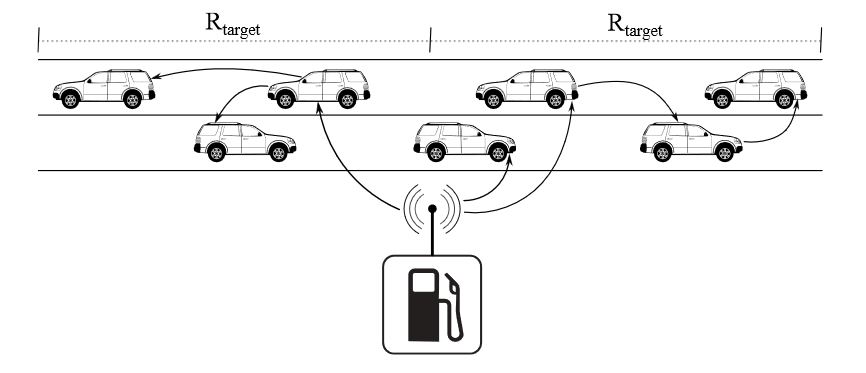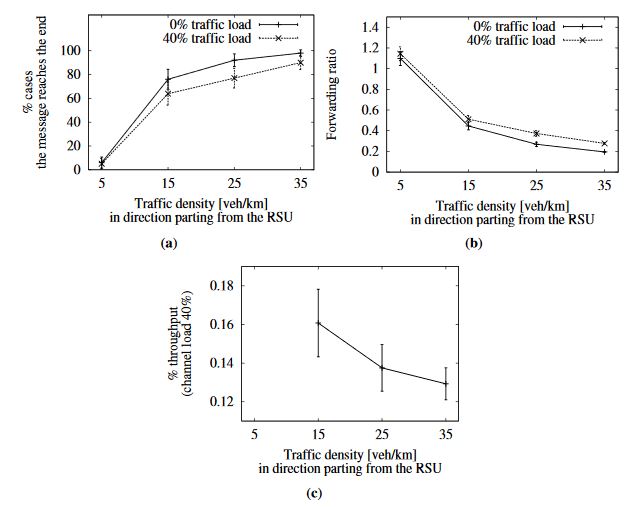ABSTRACT
Thanks to the research on Vehicular Ad Hoc Networks (VANETs), we will be able to deploy applications on roadways that will contribute to energy efficiency through a better planning of long trips. With this goal in mind, we have designed a gas/charging station advertising system, which takes advantage of the broadcast nature of the network. We have found that reducing the number of total sent packets is important, as it allows for a better use of the available bandwidth. We have designed improvements for a distance-based flooding scheme, so that it can support the advertising application with good results in sparse to dense roadway scenarios.
RELATED WORK
Location-aware services have been receiving a lot of attention in the last few years, and the research community is working on different ways to provide them. For example, the work in proposes a proactive contextualization by means of prediction. A lightweight application that resides in the user’s phone constantly learns her mobility pattern according to the GSM cells to which it registers. By means of LZ-based algorithms, it is able to predict future locations and, hence, be aware of the future context.
THE ADVERTISING SYSTEM

Figure 1. Scenario representation
Therefore, when the gas station sends a message, it reaches only those vehicles that are closest to it. They are responsible for forwarding the message to the next group in each direction. Those must forward the message again, and so on, until it has reached the edge of the target area and about every vehicle in it has heard it. A visual representation is in Figure 1.
DISTANCE-BASED FORWARDING FOR EFFICIENCY
As stated before, a key necessity of our advertising system, which works in “push” mode, is to be bandwidth-efficient. At the same time, we want these messages to reach all the vehicles in the target zone, so we need to perform a broadcast. In a former work, we tested the performance of several basic broadcasting schemes.
Using prior simulations as a starting point, we concluded that distance-based flooding provides the best performance in terms of bandwidth usage and proposed a specific algorithm. Here, we optimize the formulation and propose specific values for its configuration. In addition, we provide a formal analysis of the ratio of forwarders per receiver that makes this scheme the best option for all-purpose broadcasting.
HOW TO SOLVE CASES OF LOW TRAFFIC DENSITY

Figure 2. Case depiction
If the vehicle is traveling at a lower speed than the limit, it will forward the message again before it has left the last covered area. However, the rest of the vehicles in its own direction, or the vehicles in the opposite direction, may be traveling at a speed closer to the limit, and so, they will not miss the retransmission. Let us consider the situation represented in Figure 2.

Figure 5. Case 3 depiction
The last relay and the potential new one are traveling in opposite directions, coming closer. Then, it is impossible that they get out of range of the other. This case is shown in Figure 5.
MESSAGE FORMAT
Along with the specific information (brand name, prices, etc.) that the service provider wants to spread, the station location and the target zone must be specified in the message. The provider location is unique and fixed, so it is used to detecting duplicates. The (configurable) target zone is determined by simply indicating a radius of interest. It is also necessary to replace the location and the speed of the last forwarder at every hop, so that we can make use of our distance-based flooding scheme and the store-carry-forward mechanism.
EVALUATION

Figure 10. Simulations scenario
Together with the IP and UDP headers, the total packet size is 244 bytes. We want to remark that increasing the contents of the data field causes a little increase in the packet transmission time and the probability of collision. Every simulation batch is constituted by 100 runs, each using a different random scenario. These parameters are specified in Table 3. A visual representation of the simulations scenario is in Figure 10.

Figure 15. Performance when the wireless channel is loaded to 40%. Confidence interval of 95%.)
On the other hand, we can see in Figure 15c that, despite the extra retransmissions, the percentage of the total throughput, due to the dissemination, is still low, around 0.15% at most. When the traffic density is very low, the dissemination stops soon, so this case is negligible and is not represented in the graphs. In addition, we can notice how the percentage gets smaller as the traffic density is higher. This is due to the lower number of retransmissions that comes from a higher probability of finding new neighbors at each hop.
CONCLUSIONS AND FUTURE WORK
In this work, we have described a new service discovery solution for roadways. It will allow gas/charging stations to advertise their locations. This way, drivers can plan their next stop better on long trips, saving energy and CO2 emissions. A simple approach, pushing short messages into a target radius, has proven to be enough for the gas station advertising system. In fact, the key of the system is a bandwidth-efficient flooding. Here, we have optimized our own previous proposal and added a customized store-carry-forward mechanism in order to achieve this goal.
We have tested the solution through extensive simulations and compared it to a state-of-the-art proposal, DV-CAST, with satisfactory results. This solution is aimed at the planning of long trips and, hence, to a roadway environment. However, it could be useful for other purposes in a city scenario, too. As future work, we plan to do the necessary modifications in order to make it also suitable for a city environment. Furthermore, we still have to select an algorithm that will sort the incoming announcements according to the user preferences.
Source: University Carlos
Authors: Estrella Garcia-Lozano | Celeste Campo | Carlos Garcia-Rubio | Alberto Cortes-Martin | Alicia Rodriguez-Carrion | Patricia Noriega-Vivas
>> More Wireless Energy Projects for Engineering Students